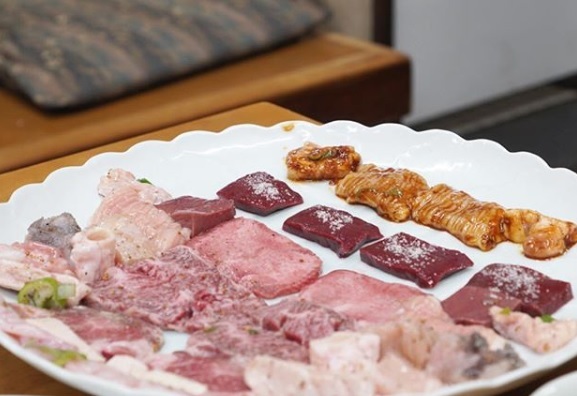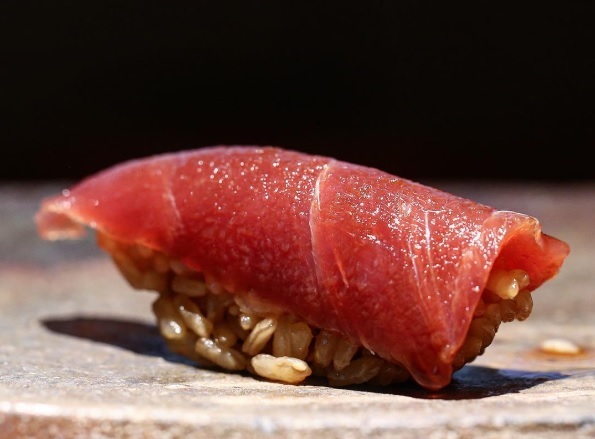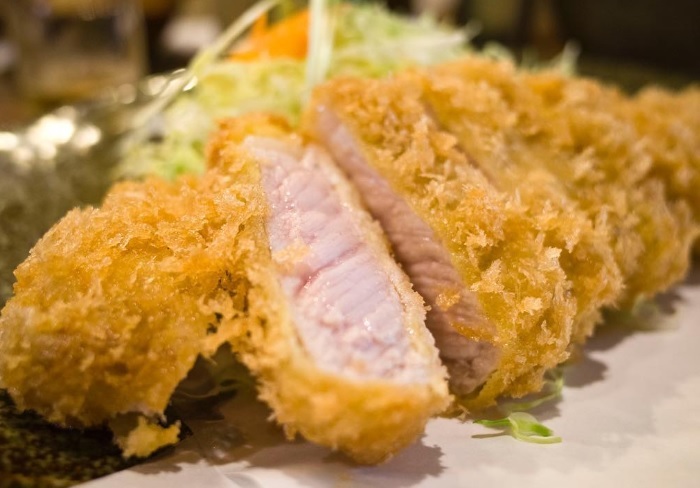Dining Like JAL First Class
Don’t get me wrong. I never fly JAL first class. Even if I could pay for the exorbitant first-class fare, I wouldn’t. Even business class is too luxurious for me. How much space or luxury does one need, anyway? In fact, a no-frills budget airline is more than enough for my trip.
But have you ever wondered what it’s like to dine like a first-class passenger, in particular, on JAL? Would that be the epitome of all fine dining experiences for the privileged few in the upper echelon? Highlights of the menu on JAL First Class feature two Kaiseki style foods and one Western-style in their inflight dining. I’d like to review 3 restaurants whose menus are featured in-flight for JAL first-class passengers.
2 Kaiseki Restaurants in Kagurazaka
Both Ishikawa and Kohaku are in Kagurazaka, a short walk from the Iidabashi Station and a stone’s throw away from each other. It’s an area that is quite vibrant after sunset. Kagurazaka Ishikawa is the first restaurant in the group. Chef Ishikawa was from Niigata, originally. The chef at Kohaku was trained at Ishikawa, while the chef at Kohaku was subsequently the youngest chef in Japan to earn 3 Michelin stars. There are three restaurants in this group, including REN.
Both Ishikawa and Kohaku have relatively big operations compared to other Kaiseki restaurants in Japan. Ishikawa has seven seats at the counter and 18 seats in the private room, while Kohaku has six seats at the counter 18 seats in the room. This kind of capacity reminded me of Ryugin, which has tables for dining much further away from the kitchen. This is the same setup as restaurants in the west and many countries in Asia where interaction with the chef in the cooking area is minimal.
Both are 3-Michelin-star Kaiseki restaurants, so diners can surely expect 3-Michelin-star treatment from exquisite tablewares, decorations, paintings, and artwork. These two restaurants are loved by many famed international food bloggers who sing endless praise. English-speaking staff is available, which makes life easier for visitors. In the old days, Ishikawa even had English-speaking staff to handle booking inquiries. However, they moved all booking for overseas guests to Omakase, so online booking is now possible.
◆Ishikawa
The first appetizer was hamo with broth jelly. I found that the broth jelly was sweeter than at other Kaiseki restaurants. Then, deep-fried kinki followed. For an appetizer, it was shima aji with grilled eggplant. I had flatfish and two types of uni. The uni was quite sweet. As I visited in early fall, I had a chance to try the aromatic deep fried matsutake. Then, we moved on to the grilled unagi dish and braised duck. Duck is not so commonly consumed in Tokyo. I rarely see any duck dish in Japanese staple, except in Kyoto. Ishikawa also served kegani hotpot, which suits a cold fall night. For the rice dish, I had the blackthroat seaperch gohan. The dinner was concluded with selections of grapes and almond jelly.
◆Kohaku
My meal started with junsai in jelly, which was quite refreshing. The next dish was deep fried ayu dipping in cream, a dish that showed that Koizumi-San isn’t shy regarding using Western ingredients. For owan, I had prawn ball in broth followed by braised sliced blacklip abalone. Grilled swordfish (tachiuo) was served since swordfish was in season that month. One interesting dish was sweet corn with rice, which we were instructed to wrap with nori. The next dish was kuzukiri topped with uni. This was my first time having kuzukiri as a savory dish, and I believed that the noodle was difficult to prepare well. In my dining experience, there used to be only one perfect kuzukiri, which was light as air, but now, I no longer find kuzukiri to match that experience.
I observed Kohaku had an extremely young sous chef, who was only 21 years old. This young lad deftly prepared many dishes and was incredibly focused. My prediction is one day he will be a great chef if he keeps up working like this.
The rice dish was pot rice with wild unagi. Chef Koizumi insisted on using the best ingredients. Although Kohaku is a big restaurant, chef Koizumi does check on all of his guests regularly. He’s one of the most charming Japanese chefs with good command of English.
I'd recommend both restaurants for:-
1. Aspiring international foodies who wish to conquer three Michelin stars on the red book or Tabelog gold / silver.
2. Diners in a big group.
3. Diners who prefer sitting at a table more than at a counter for private conversation. Both restaurants have the table seat option.
It’s not difficult to imagine why JAL first class picked Ishikawa and Kohaku as their menus would suit a big operation and could be prepared in advance in big lots.
Then, how to choose between Ishikawa or Kohaku. The main difference is whether you like something traditional or something with a modern twist. In sum, Ishikawa is more traditional while Kohaku isn't shy about using Western ingredients. If you don't mind seeing cream, dairy product derivatives, or Western ingredients or are a diner who likes a modern take, Kohaku would be a better choice. Personally, I prefer something more traditional, but my personal choice would be Kohaku, which I found more interesting.
I wouldn't recommend either to:
1. Diners who want the charm and hospitality of a small family-run restaurant.
2. Diners who don't care about ticking off their Tabelog or Michelin accolade list.
Maison, the newly opened restaurant by super talented chef
One of the chefs who created the first-class, in-flight menu for JAL is Chef Sota Atsumi. For me, Chef Atsumi is the one shining superstar chef. His menu at Clown Bar rocked the dining scene in Paris while he was there. His pithivier was to die for. I believe he was the first one to serve lamb brain, which looked exactly like brain, in Paris. When I heard Chef Atsumi went rogue in 2017, I couldn't have been more excited. He subsequently opened his new restaurant, Maison.
There are so many new Japanese chefs outside of Japan. Katsuaki Okiyama, Robuchon alum, and his all-Japanese crew of Abri delighted Paris with his special Katsu sandwich. Tetsuya Wakuda broke into fine dining in Sydney with his degustation menu only. Béni’s chef, Kenji Yamanaka, had worked in multiple Michelin-starred restaurants and quickly gained fans in Singapore. Chef Hideaki Sato of Ta vie in HK gained recognition in the region and once put Tengu Ryugin on Asia’s 50 Best Restaurants list. Daishin Mori of Takumi, another alumnus of Robuchon who has attained his first Michelin star, is known for his premium ingredients. These are just off the top of my head from my recent visits but do not include top sushi chefs like Chef Araki, who won the hearts of diners in London before moving to his new shop at House 1881 in HK.
But not all Japanese chefs in the West are truly great. For example, despite being loved by food critics, Masahide Ikuta of Marché des Enfants Rouges could only woo foreign tourists in Paris. But I don’t recommend this restaurant to any friends. While the online marketing is good, I know that many would endorse themselves by flaunting their experience in Michelin-starred restaurants. It becomes a dime a dozen. The cooking isn’t much for me to recommend it to anyone. I noticed that mostly food tourists would go there.
Back to Maison, Chef Atsumi opened his new restaurant in September 2019. I booked a visit three months after the opening after the problems that all new restaurants have got ironed out. Coincidentally, my booking was on the weekend of the largest French strike in decades, so there were lots of tear gas and arrests on top of disrupted public transportation, which completely paralyzed the whole country. However, I would let nothing, not typhoons or civil unrest, stand between me and my dining plan.
Maison, which means ‘house’ in French, is a 40-seat restaurant in Paris’s 11th Arrondissement, not far from Pierre Sang, one of my favorite top Korean chefs, and Père Lachaise Cemetery, which is the final resting place of Jim Morrison and many historical figures.
Atsumi-San is one of the top chefs of his generation. His approach is very revealing and bold, presenting a new taste profile that is unmistakably French with a Japanese touch. My meal started with mini tartlets made of different ingredients. He caramelized the onions, and I love the Maillard effect. Bread is made in house in the open oven from Modena, Italy. The red mullet dish was nice. Nevertheless, I have been spoiled by the best seafood in Japan. Not many fishmongers in Europe would have a technique like ikejime, which helps keep their fish in the best condition. The pigeon main dish, which came with salsifi (or salsify in English), and pigeon’s liver sauce pasta with shellfish stock was out of this world. The pigeon is cooked to medium-rare perfection. The deep taste of the liver sauce was unforgettable, and the taste lingered on my palate. Salsifi is a root vegetable in the same family as dandelions. Despite a similar look, if you don’t look carefully, it tastes different from gobo (burdock) and seems to have more fibers. Salsifi is seasonal: Oct – Jan. Most Michelin stars would have to buy from a big market while Atsumi-san got experience sourcing from a local, smaller market, which would offer what best on that day. This would be similar to sourcing raw ingredients in Japan.
Dessert is tarte tatin, a classic French dessert accidentally created maybe by Demoiselles Tatin (Tatin sisters at Hotel Tatin) now popular around the world. It’s not any normal tarte tatin. I also had excellent tarte tatin at Benoit the day before, but Azumi-san’s tarte tatin was hand downs the best tarte tatin. Choosing an apple that doesn’t turn into apple sauce after being cooked and still holds the shape is crucial. Atsumi San used the whole apple for each portion. It is, again, deceptively simple, yet delicious beyond words.
Atsumi-san’s cooking is top-notch but it’s not, nor does it pretend to be classic 3 Michelin star cooking, so you don’t get to see lots of foaming, fancy plating, or ultra-lux ingredients. His lunch and dinner are modestly priced, ranging from approx 55 euros and 90 euros, compared to 1,000 euros at some Paris restaurants.
Service is very good, and I felt so relaxed being served by his international crew. They didn’t assign particular wait staff for each table like restaurants in the United States so different staff might serve different dishes. The French who came to serve on my left side explained in French, while on the other side, another friendly Japanese lady explained in Japanese. Another waiter spoke with me in English. If you are a polyglot, you will love the experience.
Conclusion
If I were to fly JAL first class, based on my experience at their restaurant and challenges not preparing Kaiseki à la minute, I would pick the menu by Maison as I believe Kaiseki should only be prepared à la minute. Once the food leaves the hands of the chefs, the optimum moment would be gone too quickly. If you happen to be in Paris, don’t miss the opportunity to visit Maison.
Writer:Localtaste
Local taste had taken a long journey searching for delicious meals long before the dawn of social media, roaming from one city to another from the Far East to the west, over 160 cities in four continents and more than 400,000 miles during the last 37 years.
His dining spots over thousands of restaurants range from eating in a hole in the wall in Asia to all ten Michelin 3-star restaurants in Paris. More than decades was spent on chasing for perfect xiao long bao.
Because he is not in food business nor food writer, his article won’t be found elsewhere but exclusively on tokyotabletrip.com as a tribute to Leo Saito’s altruistic deed to help international visitors discover the beauty of Japanese cuisine.
Register account first.
Register










Comments 5
5
Shi
Thank you so much for the review @localtaste - We'll be flying back home from our trip in Japan in JAL First so this is especially relevant for us and as such sincerely appreciated! Grateful for your analysis and recommendations.
Menchikatsu
Wonderfully refreshing article, localtaste and Saito-san. It's something new, not often spoken about, and fits exactly the tone of your travelers experience site.
I touched on the topic in ChuToroZuke's page, about JAL's recent BEDD menu, and their decision to bring on some high profile chefs.
I've had the good fortune of traveling a couple times recently on Japan Airlines' business class, and sampled their food menu. The Japanese movie selection and big individual tv is probably the biggest plus. I've sat just about everywhere on a JAL plane, from the very back, and once in my life in first class, when I was much younger. Something particularly funny as a memory for me, was why I noted their service was much better than all other airlines. Not only was I seated right in the center, in a leather reclining sofa. But they would bring me any kind of alcohol I wanted. I was... not 'of age' at the time. Nobody around me knew, because they were all asleep, thanks to the comfy chair, haha.
I've only tried the business class level for the new menu. But I asked to see what first class was eating, and it read on the Ishikawa/Koizumi offering, a course including sukiyaki/shabu.
From what I remember of my meal at Kohaku, the dashi gelee was really quite good. Rather than unagi, the rice pot for the night was turtle. We were seated at a table, and my assumption was that counter seats are much more enjoyable and exciting, as it's a somewhat boring room without the direct interaction. I do remember the one time he greeted us on our way out, and his excellent English. "My name is Koji," he said.
I've not been to Ishikawa, but my friend said he drank with them as the last guest seating, and it was a blast. I once watched a documentary, where it shows their prep process, and how the whole team is made to taste every ingredient early that day.
I have an appointment to eat at their apprentice's restaurant in America, Hayato.
Is Maison... related to the current tv show Le Grand Maison, starring Kimura Takuya? Hahaha. I caught one episode, and noticed they utilize real restaurants to do the food styling. Quite noticeable on this episode, were the unmistakable dishes at Quintessence.
I believe, at least until this recent addition of Atsumi, that Yosuke Suga looks over the first class western dining option.
On business, Jun Kurogi makes the Japanese menu.
Curiously... these two previous names were both the picks for the attempt at relaunching the Iron Chef tv show. I made note of that, the minute I saw their faces on the menu.
Shinobu Namae of L'Effervescence handles the business class western menu. If ChuToroZuke is reading, because I know you're a fan of this restaurant. JAL has quite a respectable sake menu too, I remember seeing Zaku and Toyobijin on the list. You used to get your own individual little bottle, but now they pour from a large format bottle.
For snacks, you can even order a Tsuta branded noodle.
localtaste
Pen magazine just published a very nice article about Sota Atsumi in his own words. I hope TTT readers might like it. https://pen-online.com/food/sota-atsumi-a-natural-chef/?scrolled=2
guest
Thanks for the review. Given the tone, you don’t Think the kaiseki restaurants deserve their accolades?
Leo Saito
chief editor, TokyoTableTripThis is the latest article written by localtaste. The part about Maison, the new restaurant that Sota Atsumi opened in Paris, is a must-read for foodies!